RTMP is an acronym for the term ‘Real-Time Messaging Protocol’. You may have come across it in regards to live streaming and broadcasting live events. It has been used to stream over the internet (both audio and video) since back in 2002.
This was precisely when micro media was created as well. Macromedia is a broad term for content created by companies, brands and individuals. It’s housed on an online channel for public access. Every viewer with a device and internet connection will have access to Macromedia.
When RTMP was first created, it was proprietary but Adobe stepped forward in 2008, bought it, and made it publicly available. Thanks Adobe!
What does RTMP do?
In simple terms, there are three distinct steps that make RTMP ingest work:
- The handshake
- The connection
- The stream.
This sequence of events happens in just a few seconds.
During the live streaming process, the live video travels in the following route:
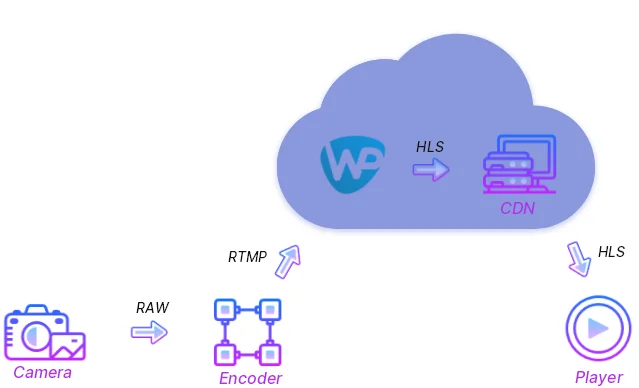
In more technical terms, RTMP allows for a constant connection between the player (client/user) and a server. It is similar to a pipe through which data moves through to get to the viewer. The initiator (client/user) requests the accepter (server) to begin a connection.
The accepter responds, the initiator receives the response and the transmission begins by maintaining a session between the initiator and the accepter. Whether the RTMP live stream is coming from an IP camera, mobile app, or external broadcasters, WpStream makes the conversion and the transmission of the stream as smooth as possible.
Although the process is highly technical and may leave you confused as a broadcaster, rest assured that if you have a reliable Video Hosting Platform, all you have to worry about is how to set it up and go live in less than 10 minutes.
Is RTMP Popular?
RTMP encoders are still a go to for many streamers. You will find almost every broadcasting platform out there supports Custom RTMP as a feature. For those who do not, you will find a bunch of disappointed customers asking why not.
External broadcasters such as Streamlabs, OBS Studio, StreamYard, Restream, Zoom, and many others accept RTMP. If you wish to go live on your WordPress website, you will need Custom RTMP that you will get from WpStream.
In 2019, respondents were asked about different streaming formats. Right after HLS, RTMP was the most popular with about 33% of respondents claiming to use it.
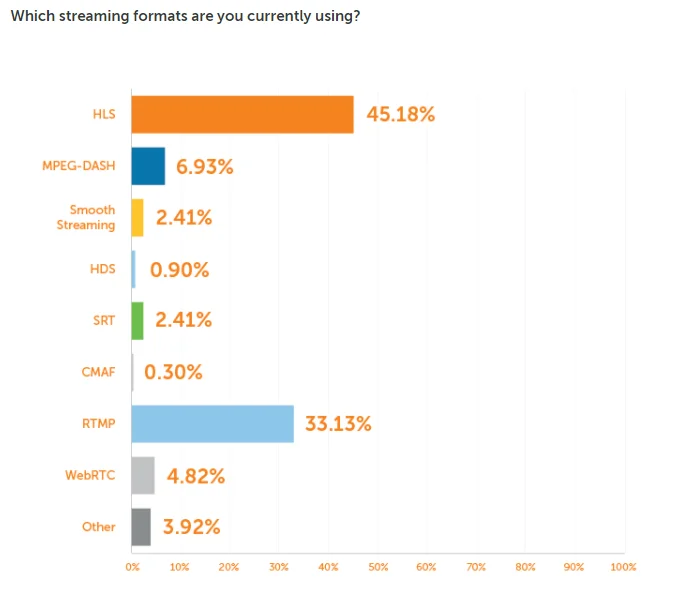
What is Custom RTMP?
Since we discussed what RTMP is and that it is basically the process of conversion and transmission of a stream, what exactly is Custom RTMP? It is often automatically generated by a Video Hosting Platform. This is essentially the ‘destination’ of your broadcast. Where you are planning to broadcast for viewers to watch.
When you use an external broadcaster or a camera, you will find that you are able to broadcast to a specific (or multiple channels). This may be YouTube Live, Facebook Live, Twitch, etc. Many external broadcasters already have these channels set up so that you can quickly go live.
However, you may have a different platform that is not available on the broadcaster by default. This is when Custom RTMP comes in. It is the Server URL and the Stream key to the destination of where you wish to broadcast. As stated in the previous section, most broadcasters/encoders will allow you to conduct streaming.
“Custom RTMP” simply means you’ll create a unique streaming channel in OBS based on parameters provided by your streaming platform.
To use Custom RTMP, you’ll need two values from the platform you want to stream to (WpStream):
-
A Server URL, and
-
A Stream Key/ID
WpStream will automatically generate a Custom RTMP for you when you create a channel, after you Start a Live Event. Once you have these two parameters, you’ll enter them into OBS Studio and set up a channel to stream to your WordPress website. This lets the broadcaster know that this is the destination that you wish to broadcast to.
How to Set Up your Stream?
Before you continue, make sure you download one of the external broadcasters that accept Custom RTMP. Above are a few of the possibilities that you could go for including the instructions and video tutorials. In this demonstration, I will be using OBS Studio and you can download the broadcaster from their website directly.
Windows, Mac, and Linux all support OBS Studio. Next, you will need a video streaming plugin for your WordPress website which you can get here. Once you have those ready, create an account with WpStream, sign in, and you can get started.
Go to ‘Channels’ under ‘WpStream’ and create a new free channel.
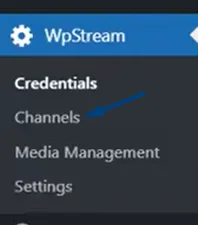
Enter any details such as the title, bio, featured image, tags, and categories and publish your channel. Once published, you can Start a Live Event.
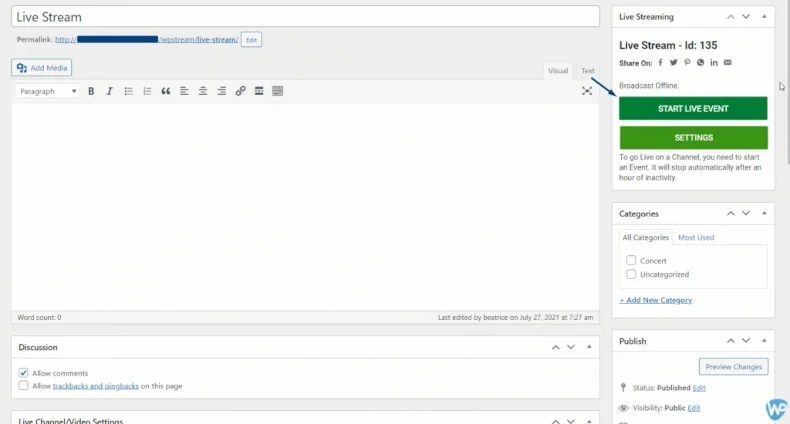
Click on ‘Go Live with External Broadcaster’. You will find a ‘Server’ and ‘Stream Key’ which are both part of the ‘Custom RTMP’ that we have been discussing in this article.
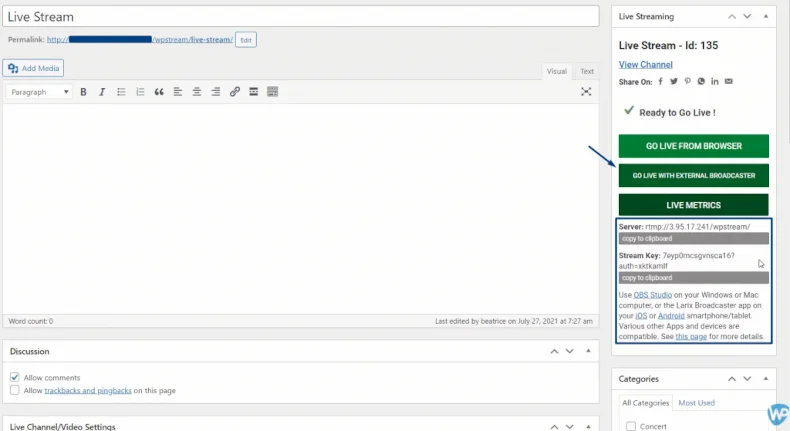
Open OBS Studio and Go to ‘Settings’, ‘Stream’ and Copy/Paste the Server and Stream Key from WpStream into OBS Studio in their respective fields. Once you have done that, click ‘OK’. Go to ‘View Channel’ on WpStream and it will take you to your live broadcast.
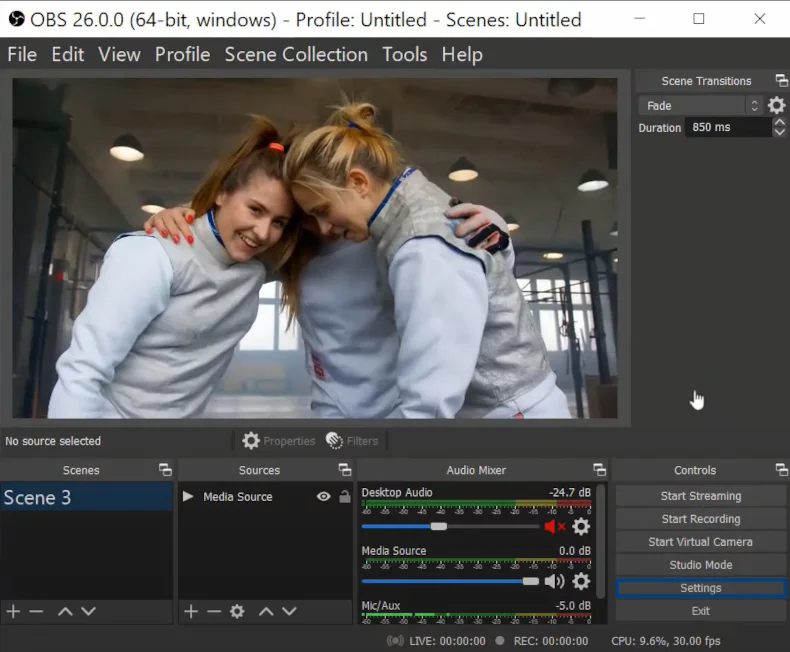
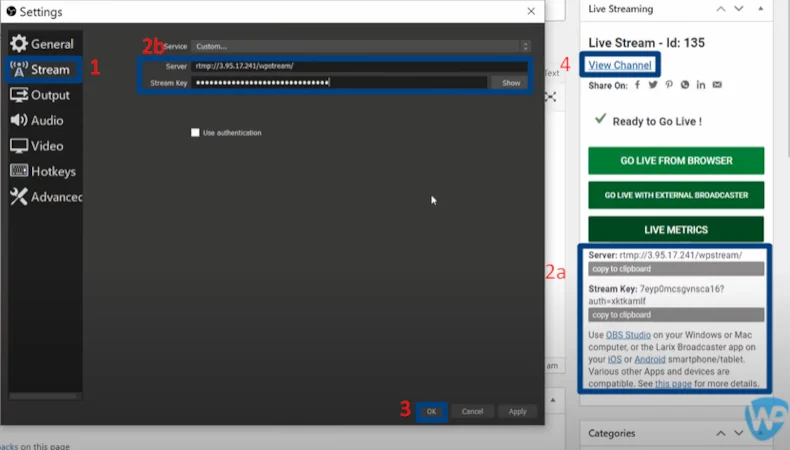
Here is your live broadcast that was made possible
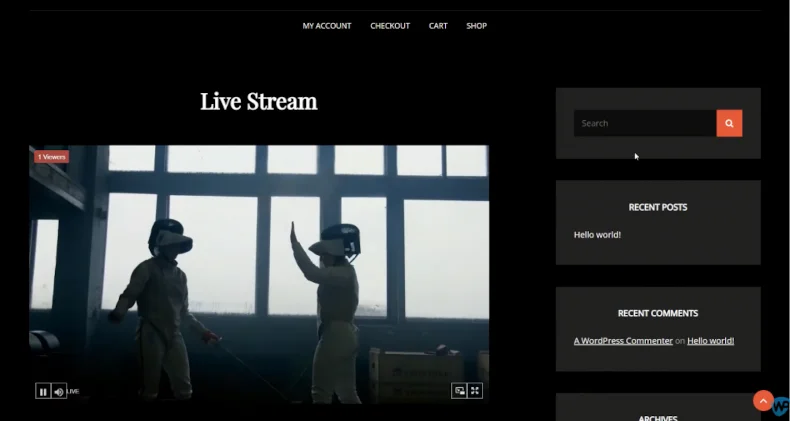
Pros and Cons
Get your list out and start noting down the positives and the deal breakers when it comes to RTMP streaming.
Pros
- Quite stable and delivers great quality streams in a timely fashion. This is why it is still one of the most popular streaming formats available in the streaming industry and why it will continue to be for years to come.
- Most External Broadcasters support it so you will be able to find the right one for you whether it is for free or paid
- Low buffering which goes hand-in-hand with delivery of quality streams. It is a reliable streaming format and some of the most popular platforms
- Multicast support. You can use Custom RTMP to broadcast to multiple platforms including your WordPress website, Facebook Live, and YouTube Live.
Cons
- Some tight firewalls might not allow RTMP connections due to the low security of delivering videos
- Relatively low latency compared to other protocols
Conclusion
RTMP streaming is one of the most popular streaming formats that you will find on the internet and broadcasters rely in it to live stream quality content in real-time. Whichever Video Hosting Platform and external broadcaster you choose to go with, I can guarantee that you can use your Custom RTMP to broadcast.
It is simple, time efficient, and although can be quite technical, with the right Video streaming platform, you can put that worry aside. Here at WpStream, we provide you with the live streaming tools and you provide the content for your viewers to enjoy.
Are you looking for a Video Streaming Plugin for your WordPress website and brand? WpStream will get you started in no time.
Start your free trial with WpStream today and experience the ability to broadcast live events, set up Pay-Per-View videos, and diversify the way you do your business.
Table of Content







